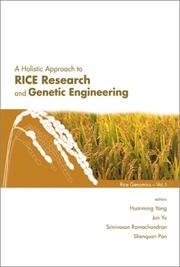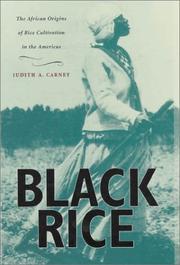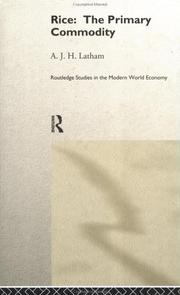| Listing 1 - 10 of 41 | << page >> |
Sort by
|
Book
ISBN: 9781107044395 9781107360266 9781107622371 1107360269 9781316204061 1316204065 1107044391 1107622379 1316191095 1316211444 1316189252 1316209555 1316205886 1316207692 Year: 2015 Publisher: New York, NY
Abstract | Keywords | Export | Availability | Bookmark
 Loading...
Loading...Choose an application
- Reference Manager
- EndNote
- RefWorks (Direct export to RefWorks)
Rice today is food to half the world's population. Its history is inextricably entangled with the emergence of colonialism, the global networks of industrial capitalism, and the modern world economy. The history of rice is currently a vital and innovative field of research attracting serious attention, but no attempt has yet been made to write a history of rice and its place in the rise of capitalism from a global and comparative perspective. Rice is a first step toward such a history. The fifteen chapters, written by specialists on Africa, the Americas, and Asia, are premised on the utility of a truly international approach to history. Each brings a new approach that unsettles prevailing narratives and suggests new connections. Together they cast new light on the significant roles of rice as crop, food, and commodity and shape historical trajectories and interregional linkages in Africa, the Americas, Europe, and Asia.
HISTORY / World. --- Rice --- History. --- Lowland paddy --- Lowland rice --- Oryza sativa --- Paddy (Plant) --- Padi --- Palay --- Oryza
Book
ISBN: 1281968072 9812814299 9789812814296 9812818685 9789812818683 9789812818683 9781281968074 Year: 2001 Publisher: Manila, Philippines International Rice Research Institute
Abstract | Keywords | Export | Availability | Bookmark
 Loading...
Loading...Choose an application
- Reference Manager
- EndNote
- RefWorks (Direct export to RefWorks)
The Rice Genetics Collection of past symposia and other selected literature contains nearly 4,400 pages of searchable information on rice genetics and cytogenetics published by the IRRI and its partners since 1964. In addition to the five genetics symposia held at 5-year intervals since 1985, the collection contains classic publications that kicked off significant reporting on these subjects in the early 1960's. This collection is a comprehensive and historical documentation on the subject of rice genetics, spanning 45 years of research and scholarly work. Published in 2000, Rice Genetics IV contains 31 chapters from various contributors on topics dealing with rice genetic research, including molecular markers, genetic diversity, and evolution; structural and functional genomics; gene isolation and function; and transformation.
Rice --- Lowland paddy --- Lowland rice --- Oryza sativa --- Paddy (Plant) --- Padi --- Palay --- Oryza --- Genetics --- Genetic engineering --- Yields

ISBN: 1281933872 9786611933876 9812791345 9789812791344 9812383506 9789812383501 9812382070 9789812382078 Year: 2003 Publisher: River Edge, N.J. : World Scientific,
Abstract | Keywords | Export | Availability | Bookmark
 Loading...
Loading...Choose an application
- Reference Manager
- EndNote
- RefWorks (Direct export to RefWorks)
The aim of this book series is to familiarize scientists, students and the general public with exciting new discoveries and developments in rice genomics. Leading scientists in rice genomics and related fields are invited to write articles in a cohesive format that appeals to both researchers and laypersons with an interest in genomics and biotechnology. The first volume provides the background information and highlights the major achievements in rice genomics; ongoing developments in this exciting field are also discussed. This volume promotes genomics as a holistic approach to rice research and genetic engineering.
Rice --- Lowland paddy --- Lowland rice --- Oryza sativa --- Paddy (Plant) --- Padi --- Palay --- Oryza --- Genetic engineering. --- Genetics.
Book
ISBN: 0128115092 0128115084 9780128115091 9780128115084 Year: 2019 Publisher: Duxford, United Kingdom : Woodhead Publishing, An imprint Elsevier,
Abstract | Keywords | Export | Availability | Bookmark
 Loading...
Loading...Choose an application
- Reference Manager
- EndNote
- RefWorks (Direct export to RefWorks)
Rice --- Analysis. --- Composition. --- Processing. --- Rice processing --- Lowland paddy --- Lowland rice --- Oryza sativa --- Paddy (Plant) --- Padi --- Palay --- Oryza

ISBN: 0674029216 9780674029217 0674004523 9780674004528 0674008340 9780674008342 0674262530 9780674262539 Year: 2001 Publisher: Cambridge, MA : Harvard University Press,
Abstract | Keywords | Export | Availability | Bookmark
 Loading...
Loading...Choose an application
- Reference Manager
- EndNote
- RefWorks (Direct export to RefWorks)
Few Americans identify slavery with the cultivation of rice, yet rice was a major plantation crop during the first three centuries of settlement in the Americas. Rice accompanied African slaves across the Middle Passage throughout the New World to Brazil, the Caribbean, and the southern United States. By the middle of the eighteenth century, rice plantations in South Carolina and the black slaves who worked them had created one of the most profitable economies in the world. Black Rice tells the story of the true provenance of rice in the Americas. It establishes, through agricultural and historical evidence, the vital significance of rice in West African society for a millennium before Europeans arrived and the slave trade began. The standard belief that Europeans introduced rice to West Africa and then brought the knowledge of its cultivation to the Americas is a fundamental fallacy, one which succeeds in effacing the origins of the crop and the role of Africans and African-American slaves in transferring the seed, the cultivation skills, and the cultural practices necessary for establishing it in the New World. In this vivid interpretation of rice and slaves in the Atlantic world, Judith Carney reveals how racism has shaped our historical memory and neglected this critical African contribution to the making of the Americas.
Rice --- Slaves --- Enslaved persons --- Persons --- Slavery --- Lowland paddy --- Lowland rice --- Oryza sativa --- Paddy (Plant) --- Padi --- Palay --- Oryza --- History.
Periodical
ISSN: 18764762 16726308
Abstract | Keywords | Export | Availability | Bookmark
 Loading...
Loading...Choose an application
- Reference Manager
- EndNote
- RefWorks (Direct export to RefWorks)
Rice --- Rice. --- Research --- Research. --- Lowland paddy --- Lowland rice --- Oryza sativa --- Paddy (Plant) --- Padi --- Palay --- rice science --- Oryza --- Agriculture Sciences --- Horticulture and Plant Culture (including Arboriculture) --- Plant husbandry
Book
ISBN: 9535112406 9535142348 Year: 2014 Publisher: IntechOpen
Abstract | Keywords | Export | Availability | Bookmark
 Loading...
Loading...Choose an application
- Reference Manager
- EndNote
- RefWorks (Direct export to RefWorks)
Rice is a staple food for half of the worlds population mostly in Asia. Productivity of rice has largely been improved since the Green Revolution in 1960s. Further improvement of rice yield is necessary to keep pace with population growth, which is a challenging task for breeders. This book, Rice - Germplasm, Genetics and Improvement, as its name implies, comprehensively reviews current knowledge in germplasm exploration, genetic basis of complex traits, and molecular breeding strategies in rice. In the germplasm part, we highlight the application of wild rice in rice breeding. In the genetics part, most of the complex traits related with yield, disease, quality have been covered. In the improvement part, Chinese experiences in hybrid rice breeding have been summarized together with many molecular breeding practices scattering in different chapters.
Rice. --- Lowland paddy --- Lowland rice --- Oryza sativa --- Paddy (Plant) --- Padi --- Palay --- Oryza --- Life Sciences --- Agronomy --- Agricultural and Biological Sciences --- Plant Genetics
Book
ISBN: 0857092790 1845694856 9781845694852 9780857092793 Year: 2011 Publisher: Cambridge ; Philadelphia : Woodhead Pub.,
Abstract | Keywords | Export | Availability | Bookmark
 Loading...
Loading...Choose an application
- Reference Manager
- EndNote
- RefWorks (Direct export to RefWorks)
Rice is a unique and highly significant crop, thought to help feed nearly half the planet on a daily basis. An understanding of its properties and their significance is essential for the provision of high quality products. This is all the more true today as international trade in rice trade has been increasing rapidly in recent years. This important book reviews variability in rice characteristics and their effects on rice quality.After an introduction on rice quality that also explores paradoxes associated with the crop, the book goes on to examine rice physical properties and milling
Rice -- Analysis. --- Rice -- Milling. --- Rice -- Quality. --- Rice --- Agriculture --- Earth & Environmental Sciences --- Plant Sciences --- Quality --- Milling --- Quality. --- Milling. --- Lowland paddy --- Lowland rice --- Oryza sativa --- Paddy (Plant) --- Padi --- Palay --- Oryza

ISBN: 0203278321 0415151538 128031818X 0203442180 9780203278321 9780203442180 1134745826 9780415151535 9781134745821 9781134745777 9781134745814 1134745818 Year: 1998 Publisher: London New York Routledge
Abstract | Keywords | Export | Availability | Bookmark
 Loading...
Loading...Choose an application
- Reference Manager
- EndNote
- RefWorks (Direct export to RefWorks)
Including case studies of Japan, India, Brazil, Malaysia and many other countries this unique book gives an up-to-date and comprehensive account of the unpredictable and rapidly changing world market in rice.
Rice trade. --- Rice trade --- Rice --- Industries --- Business & Economics --- Rice. --- Lowland paddy --- Lowland rice --- Oryza sativa --- Paddy (Plant) --- Padi --- Palay --- Rice industry --- Oryza --- Grain trade --- E-books
Book
ISBN: 9535130307 9535130293 953515480X Year: 2017 Publisher: IntechOpen
Abstract | Keywords | Export | Availability | Bookmark
 Loading...
Loading...Choose an application
- Reference Manager
- EndNote
- RefWorks (Direct export to RefWorks)
Rice is life, for most people living in Asia. Rice has shaped the cultures, diets, and economies of thousands of millions of people. Growing, selling, and eating rice are integral to the culture of many countries. Products of the rice plant are used for a number of different purposes, such as fuel, thatching, industrial starch, and artwork. Rice is the staple food of more than half of the world's population - more than 3.5 billion people depend on rice for more than 20% of their daily calories. Asia accounts for 90% of global rice consumption, exceeding 100 kg per capita annually in many countries. Keeping in view the importance of rice, the United Nations declared 2004 as the International Year of Rice. Food security, which is the condition of having enough food to provide adequate nutrition for a healthy life, is a critical issue. Sustainable rice production is important for food self-sufficiency and food security in changing climates. Sustainable rice production practices are those which (1) increase rice productivity and its quality, (2) improve soil fertility and health, (3) increase water use efficiency and conservation, and (4) increase diversification of rice fields, growers' income, and climate resilience.
Rice. --- Lowland paddy --- Lowland rice --- Oryza sativa --- Paddy (Plant) --- Padi --- Palay --- Oryza --- Life Sciences --- Food Technology --- Agricultural and Biological Sciences --- Bromatology
| Listing 1 - 10 of 41 | << page >> |
Sort by
|

 Search
Search Feedback
Feedback About UniCat
About UniCat  Help
Help News
News